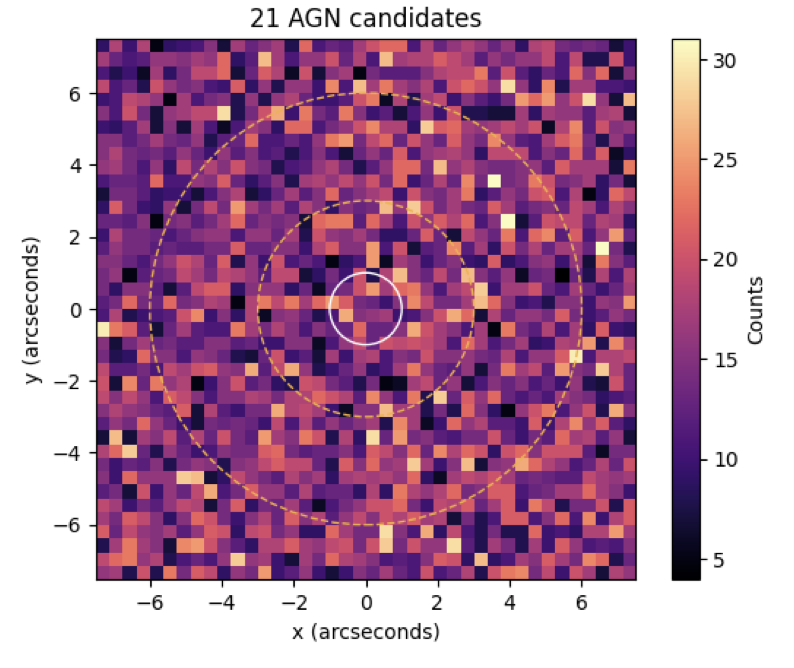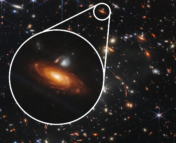Title: X-ray View of Little Red Dots: Do They Host Supermassive Black Holes?
Authors: Tonima Tasnim Ananna, Ákos Bogdán, Orsolya E. Kovács, Priyamvada Natarajan, Ryan C. Hickox
First Author’s Institution: Department of Physics and Astronomy, Wayne State University, Detroit, MI 48202, USA
Status: Submitted to the Astrophysical Journal Letters [open access]
Among the fascinating objects observed by JWST are galaxies in the early universe known as little red dots (LRDs, read more about them here and here!). These galaxies are believed to be rich in dust which contributes to their distinct red hue. Studying the spectra of LRDs in infrared wavelengths using JWST reveal the presence of strong emission lines. This emission can be a potential indicator of an active black hole or vigorous star formation. That leaves us with a tantalizing question-which one is it!?
If the LRDs indeed host black holes, the masses of these black holes have been found to be between ten million to a billion times more massive than the Sun. This poses a significant challenge-how can these black holes accumulate such large masses in such a short time from their births? This question has left astronomers puzzled, highlighting the need to understand if these LRDs do, in fact, hold overdense black holes.
In astronomy, akin to life, sometimes it helps to take a step back and observe something from a different perspective. Looking at the LRDs through a different wavelength of light can help understand what exactly is happening in them. Today’s authors set out to harness the power of multiwavelength astronomy, and look at these LRDs at X-ray wavelengths to see if they emit any X-ray signals. Even though both black holes and star forming activity can emit in the X-ray, the difference between the strength of the X-ray emission between the two is more significant in the X-ray than infrared. So, obtaining the strength of X-ray luminosity from the LRDs should give us a good idea of whether the X-rays are caused by a black hole or by stellar processes.
The authors select a bunch of LRDs that are hidden behind a big galaxy. Since X-rays can be challenging to detect, a massive galaxy in front can act as a gravitational lens and magnify any X-ray signals from the LRDs. If LRDs indeed host really massive black holes, it is not unreasonable to expect X-ray signals from them.
Lo and behold! There are none!
The authors do not find any detections of X-rays from the LRDs. To further improve sensitivity, in case the X-ray signal is too weak to be determined from individual galaxies, the authors also stack the galaxies. X-rays were still undetected with significant confidence from the LRDs (Figure 1).

If there was a black hole of mass 107 – 109 M☉ present in the LRD, there is a well-known estimate of the X-ray luminosity that should be measured. Using this correlation, one can obtain conservative limits to the maximum mass of the black hole, if any, that might be present in the LRDs. The authors assume accretion at the Eddington limit, a theoretical maximum rate at which a black hole can grow by accretion of mass, and obtain black hole masses less than 1.5 x 106 M☉ (Figure 2). This is a couple of orders of magnitude lower than the black hole masses in LRDs determined by other works.

This mismatch may arise due to the method by which the black hole masses were estimated in these LRDs. Masses were determined using broad emission lines, which have been standardized based on nearby galaxies with AGN and thus may not work for galaxies at much higher redshifts. It is also possible that the X-rays were not detected because these galaxies are incredibly dusty, but the authors believe that to be very unlikely.
The mystery of LRDs continues!
This work suggests that LRDs will not likely host extremely overdense black holes. More data coming from JWST, including a detailed study of the spectra of these LRDs, can help us understand them better. This work primarily uses data from the Chandra X-ray Observatory, which has now unfortunately been defunded despite continuing to produce very significant scientific results (Read here to find how you can save Chandra!). The mysteries of the universe will ultimately be solved only by looking at it from every possible wavelength, and we need such multiwavelength telescopes to achieve this lofty goal!
Astrobite edited by Janette Suherli
Featured image credit: NASA and Wikimedia Commons




